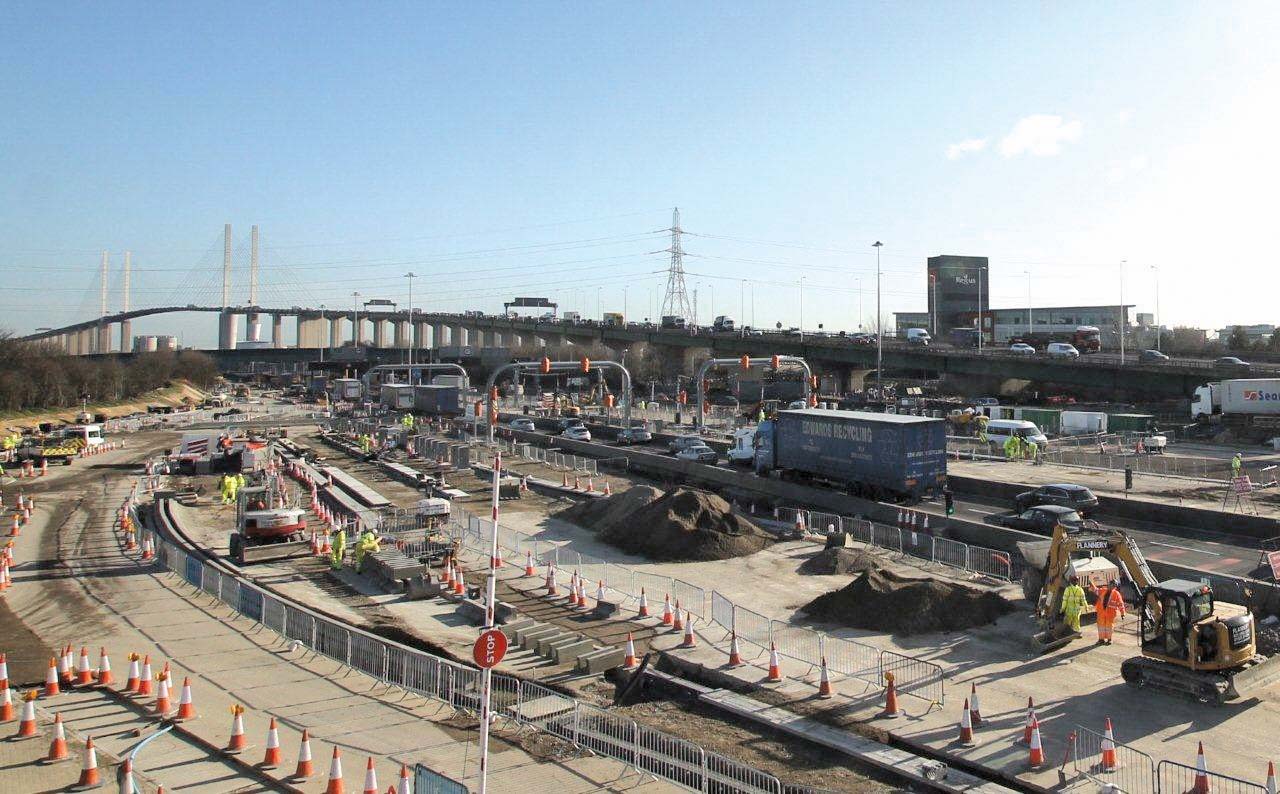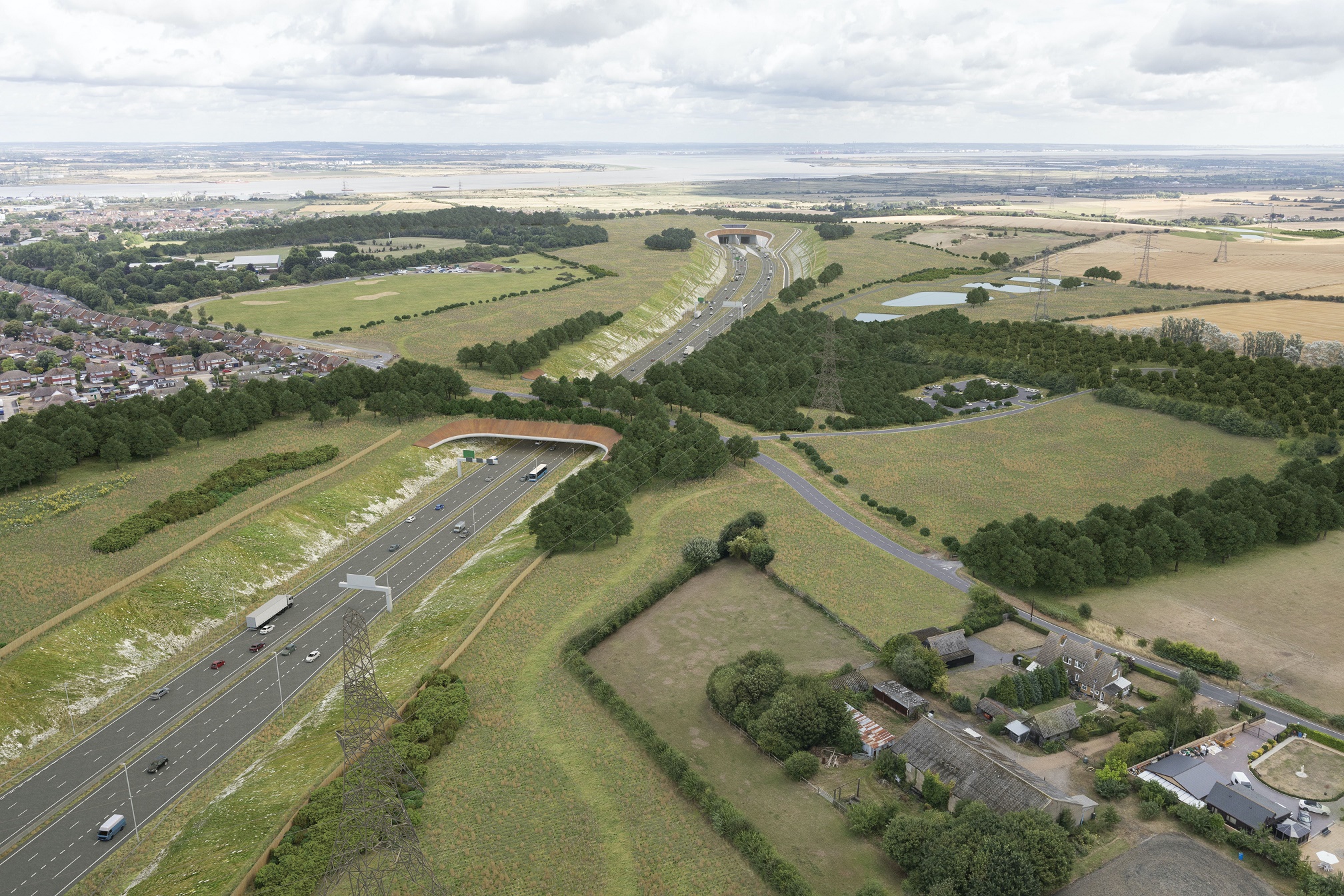
Colin Sowman looks at the transition to free-flow charging on the Dartford Crossing, a notorious congestion blackspot on the UK motorway network.
The Dartford Crossing, where London’s orbital M25 motorway crosses the lower reaches of the River Thames 32km (20 miles) to the east of Central London, has long been a major source of congestion. Now, to alleviate the congestion caused by some 50 million crossings per year, the
Opened in 1963, just as many railway lines were being decommissioned, the Dartford crossing initially replaced a ferry service with a single tunnel carrying one lane in either direction. Toll booths at the southern end collected tolls from an estimated two million users who wanted to avoid a 56km (35 mile) detour into central London to cross the Thames. Increasing traffic volumes led to a second, and slightly bigger, bore (to the east of the first) being added in 1980, allowing the separation of the northbound and southbound carriageways. In 1986 the M25 was completed, leading to a big increase in traffic and by 1991 a four lane cable stayed bridge was completed to carry the clockwise traffic, leaving both tunnels for the anti-clockwise carriageways.
By the time the bridge opened, the number of toll booths had been increased to 27 (14 northbound and 13 southbound) giving a theoretical capacity of 133,387 vehicles per day or almost 48.7 million vehicles per year and yet congestion was soon endemic at peak times. So in an attempt to achieve a more even traffic volume, in 2008 the tolls were replaced by a Congestion Charge which was only levied between 6am and 10pm. Any gains were short-lived and the number of crossings continued to rise, so at the end of last year a £62million (US$95 million) project saw the introduction of an all-electronic free-flow charging system.
In place of the toll booths, 14 cameras capture the number plates of vehicles using the crossing and there is also the option for regular users to continue using an existing tag system. And as the charge varies between vehicle categories, a classification system is also included. Connect Plus has a 30-year contract to run and maintain the crossing (and other sections of roadway) on behalf of the Highways Agency, which has also signed a 10-year contract with
Both front and rear facing cameras are used to maximise the capture rate and as the crossing is on a major route to and from several ports, fonts for overseas registration plates are also loaded into the recognition libraries. Contextual cameras are also installed to support any prosecutions and these can also capture telephone numbers and company names on the sides of trucks and vans.
Nigel Gray of the Highways Agency who is project director for the Dart Charge said: “Capture rates are good and in line with the 98-99% region specified in the contract. There have been no major issues with the technology but where problems have arisen is with manual checking – we check images before a penalty notice is issued.
With 125,000 chargeable crossings per day, hundreds of manual checks are carried out every day. The system is also EETS compliant but we are not introducing interoperability from the outset.”
In moving to open road charging, the cost of a single crossing by car increased 25% (20% for commercial vehicles) although account holders get a discount (33% for cars, 13% for commercial vehicles) in comparison to those using other payment methods.
Local residents and businesses using cars and vans get unlimited crossings for £20 (US$30) and emergency and military vehicles are exempt as are certain vehicles used by disabled drivers and low emission vehicles with a zero rate of Excise Duty.
In readiness for the move to electronic charging the Highways Agency launched a major publicity campaign to inform drivers about the need to open an account or to pay the charge by phone, mail, on-line or at one of 20,000 Payzone retail outlets across the UK.
“Drivers have up to midnight on the day after they crossed to make the payment and we didn’t issue penalty charge notices for the first month, but in December we issued more than 130,000 Penalty Charge Notices – more than half of which have been settled. The first letter to each vehicle owner describes how the charge can be paid and that if the account is settled within 14 days then there is no penalty charge. Five thousand of those receiving the letter have subsequently paid and the penalty charge has been cancelled. We will do this for some time to come but it is a one-off so a repeat offender will face penalty charges,” Gray said.
By the end of February, the December compliance rate had climbed to 90% and that figure is expected to rise further. “While the target is obviously 100% we realistically expect to get around 93% and we are around where we expected to be at this point in time.”
Being so close to the ports, a relatively high proportion of vehicles are registered in other countries and in the first few months of operation details of 18,700 vehicles have been sent to a European debt recovery agency. However Gray said the process varies from one country to another: “Authorities in some countries don’t share addresses of registered keepers.”
In something of a surprise comment, Gray says the running costs of the new collection scheme are actually higher than with the manned booths: “We had 130 people employed in collecting at the booths whereas Sanef has employed 200.”
One reason is that the booths were only fully manned between 6am and 10pm whereas online payments and call centres operate around the clock. “You could have 70 or 80 people in the call centre dealing with payments, accounts and queries. Others will be reviewing images to identify non-payers’ number plates and check for foreign registered vehicles, dealing with the DVLA [Driver and Vehicle Licensing Agency] and sending out invoices and penalty notices.”
While admitting that a tag system offers the potential for lower costs, he said: “We would still need a way of capturing number plates and gathering evidence of non-payers and people to examine those images, especially for foreign registration plates which represent a significant proportion of the traffic using the crossing.
In 2013/14 the Crossing’s income was £92.5m with net proceeds of £32.1m and Gray insists the additional costs are vastly outweighed by the benefit to the UK economy from not having thousands of motorists delayed in traffic jams.
“We are not doing this to save running costs, we are doing it because of the benefit out there on the road and there are environmental benefits too. It all adds up to an extremely healthy business case.”
While the northbound roadworks have yet to be completed, the average journey times have been reduced by more than nine minutes southbound and four minutes Northbound. However even the move to electronic charging is only an interim solution as the northbound capacity only rises from 6,500 to 6,900 vehicles/hour due to the restrictions imposed by the tunnels. Southbound is a healthier 8,000 vehicles/hr and the longer term solution already being planned is the Lower Thames Crossing.
“With forecast traffic growth in the Lower Thames area increasing faster than the rest of the country, we predict pre-Dart Charge levels of congestion will have returned within 10 years - demonstrating the need for a long-term solution,” Gray concludes.









